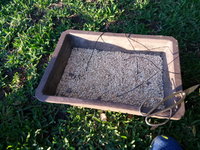miker
Chumono
Good evening all,
I haven't posted in a couple years. I was living in SE Pennsylvania but I relocated back to the Orlando area in 2019. I have a couple tropical bonsai in desperate need of work but when I visited a local nursery a couple weeks ago, Green's Nursery, they had some nice juniper in stock and this was the nicest of the bunch. One of the staff had been eyeing the available material and pointed this one out to me as the most promising of the bunch as pre-bonsai material. At $25, I thought it was more than reasonable.
I believe it to be Juniperus chinensis but I would like to get a positive ID on the species both for my information and so I have a better idea how to meet its specific cultural needs here in Florida.
I moved the tree to a position in full, all day sun last week and gave it a healthy dose of Nutricote fertilizer to get it strong and healthy.
I then figured this was the perfect time to get it potted into its training pot so I took a couple hours this afternoon and did so. I made sure to wire the plant securely into the pot, particularly since it will be residing in a windy location. I also poured the Nutricote off the top of the soil before I started and mixed it in with the final substrate. I figure, as a time-release fertilizer mixed in homogeneously, the risk of burn on the freshly pruned roots should be minimal.
The substrate consisted of a mix of stone shards, Akadama (or similar) and coarse Vermiculite for the bottom inch (with a touch of the original soil mixed in to inoculate the substrate with the microbiota extant in the original soil. The remainder of the substrate is pure coarse Vermiculite, again with a bit of the original soil for the beneficial microbes that existed in the original soil.
Tomorrow, I will be giving this tree a haircut to roughly match the amount of mass taken away from the rootball. I would have done this tonight, but I both ran out of daylight and did not have any wood glue (wound sealant on hand).
I plan to fertilize, keep the tree in full sun and keep it generously watered (but not wet) this year to get it nice and strong and will begin training the tree early next season, in the season(s) during which it is appropriate to do so for juniper.
What does everybody think of its potential as bonsai material? Any recommendations from the experts on here regarding styling/training, culture or anything else?
This thread will mark the beginning of this tree's journey toward becoming (hopefully) a nice specimen someday.
-Michael
I haven't posted in a couple years. I was living in SE Pennsylvania but I relocated back to the Orlando area in 2019. I have a couple tropical bonsai in desperate need of work but when I visited a local nursery a couple weeks ago, Green's Nursery, they had some nice juniper in stock and this was the nicest of the bunch. One of the staff had been eyeing the available material and pointed this one out to me as the most promising of the bunch as pre-bonsai material. At $25, I thought it was more than reasonable.
I believe it to be Juniperus chinensis but I would like to get a positive ID on the species both for my information and so I have a better idea how to meet its specific cultural needs here in Florida.
I moved the tree to a position in full, all day sun last week and gave it a healthy dose of Nutricote fertilizer to get it strong and healthy.
I then figured this was the perfect time to get it potted into its training pot so I took a couple hours this afternoon and did so. I made sure to wire the plant securely into the pot, particularly since it will be residing in a windy location. I also poured the Nutricote off the top of the soil before I started and mixed it in with the final substrate. I figure, as a time-release fertilizer mixed in homogeneously, the risk of burn on the freshly pruned roots should be minimal.
The substrate consisted of a mix of stone shards, Akadama (or similar) and coarse Vermiculite for the bottom inch (with a touch of the original soil mixed in to inoculate the substrate with the microbiota extant in the original soil. The remainder of the substrate is pure coarse Vermiculite, again with a bit of the original soil for the beneficial microbes that existed in the original soil.
Tomorrow, I will be giving this tree a haircut to roughly match the amount of mass taken away from the rootball. I would have done this tonight, but I both ran out of daylight and did not have any wood glue (wound sealant on hand).
I plan to fertilize, keep the tree in full sun and keep it generously watered (but not wet) this year to get it nice and strong and will begin training the tree early next season, in the season(s) during which it is appropriate to do so for juniper.
What does everybody think of its potential as bonsai material? Any recommendations from the experts on here regarding styling/training, culture or anything else?
This thread will mark the beginning of this tree's journey toward becoming (hopefully) a nice specimen someday.
-Michael


















